|
Monday, December 5, 2011
Progress Notes
This week is a followup from last week regarding the steam engine history of Miller County. Johnny DeGraffenreid, who lives in the Bear Creek area near Kaiser, is one of those who is old enough to have lived in the era when steam engine powered tractors were still being used in our county. His interest in steam engines has persisted as a life long avocation For many years Johnny has owned steam engine powered tractors and has shown them in many different venues.
Here is a photo taken quite a few years ago of Johnny with one of his steam engines (photo 01):
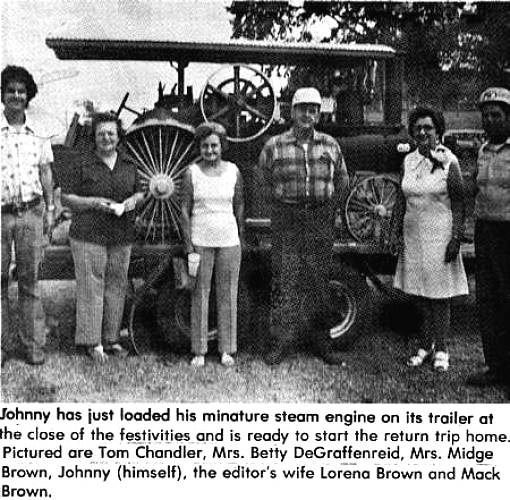
01 Johnny DeGraffenreid and Steam Engine
And here are a couple more of Johnny at a 2007 steam engine show in Boonville sent me by his granddaughter, Lori Allen (photos 01a and 01b):

01a Johnny at Boonville Show
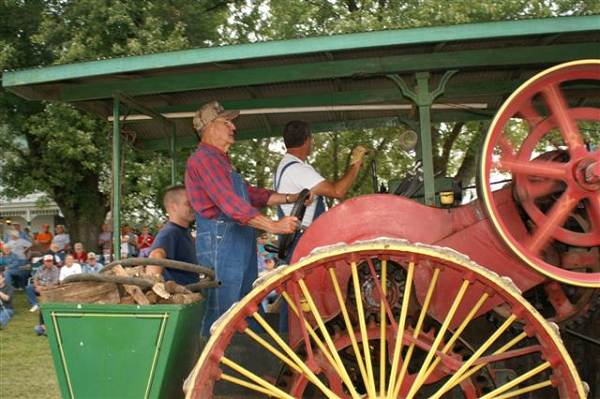
01b Johnny at Boonville Show
In 1978 Johnny wrote an article for the May/June 1978 magazine known as Iron Men Album.
In the article Johnny writes about his early interest in steam engines and his pursuit of that hobby for many years:
Johnny R. DeGraffenreid
May/June 1978
It all began in the year of 1912 when my grandfather purchased a new 18 HP single cylinder side-mounted Buffalo Pitts (photo 02).
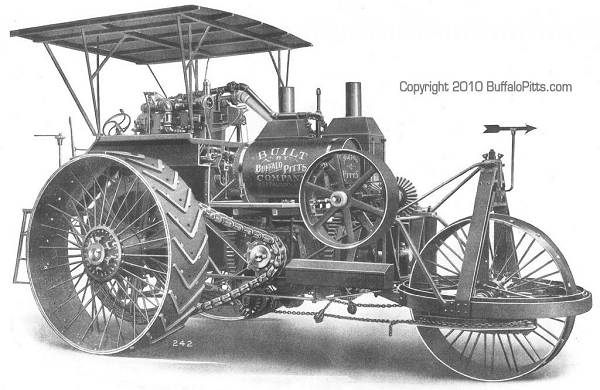
02 Buffalo Pitts Steam Engine
He purchased a grain separator at the same time and began his threshing career, in and around Bagnell, Missouri. My father said when they unloaded it off the flatcar there was a factory man with it to start them out on it.
In order to get to their home they had to cross the Osage River. This was accomplished by loading it on a barge for the crossing, which almost swamped it, dad thought. This, not being a big wheat country, they would thresh about three months and build roads and run a sawmill the rest of the time. This was about par for the course for the next 15 years, at such time they purchased a 27-44 Twin City tractor which they threshed with until about 1937 (photo 03).
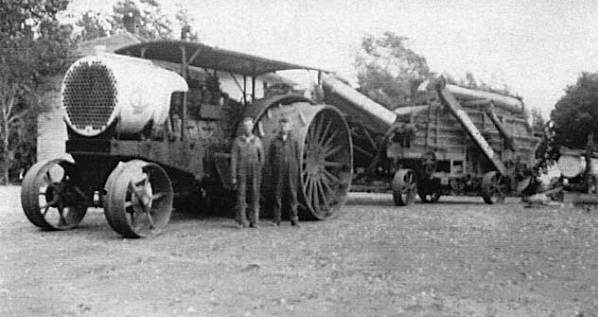
03 Twin City Steam Engine Tractor
My grandfather owned several engines during this time, but sold all but 'Old Buffalo' which he owned at his passing in 1939.
In the early 30s a friend of the family borrowed the engine and the sawmill to saw a tract of timber and in the process had a fatal heart attack while turning a log on the mill.
The old outfit set for some years and one day my father said 'Let's go get Old Buffalo,' to my brother and I. Needless to say, we were tickled pink to be in on this trip. We got the necessary buckets, funnel, wrenches etc. to make her ready for firing. We carried water for what seemed like an eternity before it came into sight in the glass, but at that point you could see progress even though small. Dad had laid the fire while we were carrying water and since it was showing in the glass, he touched the fire off and we finished filling to his satisfaction. To the best of my knowledge there wasn't a leak any place. By this time the water was beginning to boil and in a short time we could turn the blower on and the fire burned brighter and the steam began to raise faster and in a few minutes we had enough to fill the head tank and in a few minutes we were on our road home: the unheard of distance of six miles. This was on a Saturday and when night fell we were about half way home by a creek, so we took on water and got some big sticks of wood to bank the fire with and went home for a well earned supper.
The next morning we went back and kindled the fire; in a short time we were on our way home. While we were going along we would blow the whistle long and loud and several people heard it and came running to see the old engine running again and as I remember it, my mother had to set a dinner table for about 25 people that day. We went back and got the sawmill a little later and set it up and began sawing for ourselves and our neighbors.
My brother and I cared for the engine while dad did the sawing. I don't know why, but either we had plenty of water and not much steam or was it the other way around? Well, I don't know if any of you ever fired with green sycamore slabs or not but dad being a very conservative sawyer; there wasn't much left but sap. By this time the war clouds were gathering and Uncle Sam said “I Want You,” and I was almost glad to go to get out of firing the engine.
My brother and I were gone from 1940 to 1947 and in the meantime dad had gotten an old car engine for the power unit for the mill. He pulled 'Old Buffalo' off to the side and she set until the early 50s. One day a junk dealer came along and offered dad $50.00 for her and dad said the man will give $50.00 for her and I don't guess we will have any further use for her and I said he will give $100.00 and lets keep the whistle, gauge, pop valve and babbitt out of the bearings. Dad told the man what I said and needless to say he took him up on the deal.
It wasn't many years until we wished we had the engine back, but she was gone forever. I feel a little mad at this junk dealer until this day for coming along and offering a price for the engine, but if it hadn't been him I guess there would have been someone else.
We talked engines and steam for several years and in 1966 a friend of mine got me to go to Mt. Pleasant and after seeing that array of engines, the talking was no longer enough. In the spring of 1967, I heard of a number of engines at Columbia, Missouri, owned by H. H. Lawson. My brother and I went up and looked at them and a short time later I got this friend that got me to go to Mt. Pleasant to go with me and look at these engines. We made a trip or two and he bought a 22 HP single cylinder Keck Gonnerman and I bought a 20 HP double cylinder Keck-Gonnerman (photo 04).

04 Keck Gonerman Steam Engine Tractor
Now we had the job of getting them home and there was quite a bit involved as the one I got was over width and almost too high, but we made it home without any trouble and I fired mine up several times while it was still freezing weather. I began to think we needed some grain so we could have something to thresh so I prepared 10 acres of oats the first part of March. I looked at the old grain binder we had from years past and it was rotted down, so I went back to the man from whom I purchased the engine and got a 10' power binder and got it ready for harvest.
In June we got the oats bound and shocked, so we set a date for an old time threshing, did a little advertising, 'come and see if you like, no charge.' There were probably six or eight hundred people and now many people say we didn't know about it, so you will have to have it again. We have put the same ground into wheat and plan on doing it all over again. We had two large engines, one half-size Case and several small models. We had a Baker Fan which we finished making hours before the start of the show (photo 05).
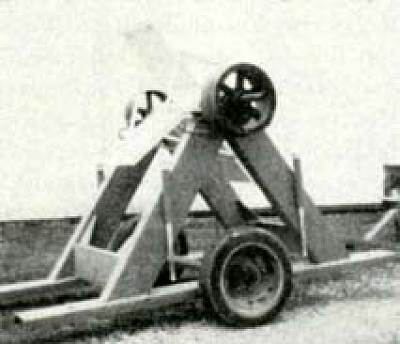
05 Baker Fan
We have another big engine, several gas engines and a number of old tractors which are all restored, also an old steam drill for next year.
My son got married in July just before the show and that is the fourth generation, so who knows, the fifth could be coming up.
Well, what do you know, 'Time slips away.' Ten years have come and gone since I wrote the first part of this article. As can happen the fifth generation has come along in fact three of them; two girls and a boy.
The threshing show has continued all these years and the 11th one was held July 23 and 24, 1977. We certainly don't have the largest show on earth and maybe not the smallest, but we have had lots of fun.
In 1969 I decided that I should build a half-scale model of the 20 HP double Keck-Gonnerman that I purchased in 1967. I started with the boiler first and made it a water bottom all riveted,3/8' material. I fabricated the engines, with a few castings of brass. I cast the lugs on the wheels out of aluminum which skin up a little on these Missouri rocks, but the old cast ones did, too. I also have the whistle off 'Old Buffalo' on the model. It was a rewarding six years of past-time and I met and corresponded with some of the nicest people in obtaining governor, injectors, pop valve, etc. Namely, Clyde Comstock, Fred Brubaker and Paul Campbell.
The first time I showed the engine publicly was at an art and craft show at Riverview Baptist Church in March of 1975 (photo 06).
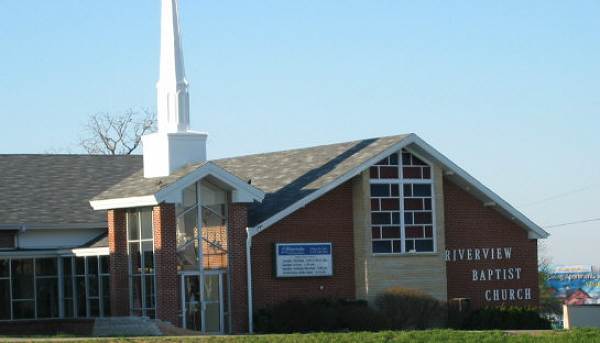
06 Riverview Baptist Church
In July I went to Paris, Missouri to the Mark Twain Old Threshers Show and I heartily recommend this show to anyone and especially model builders. In that year they had 38 models and that was a sight for sore eyes. There are many good shows, in fact I know of no bad ones. I try to make five or six each year and I enjoy every one of them for I go with that in mind. My boiler isn't a coded boiler and some states frown on that, but let me say this; I wouldn't want to operate an unsafe boiler for my own 'safety first,' then the others next.
I am an avid reader of the Iron Men Album and have been for a long time and I would say keep up the good work at any cost. The Album needs to be a daily, for I read it from cover to cover the day it comes or at the most the second day.
Johnny was one of the founders of the Osage River Antique Power Association. Below is copied an article from the organization’s website:
History of the Osage River Antique Power Association
The show was started in 1967 by Johnny DeGraffenreid, Raymond Graham and Keith Graham. These three had steam engines and held the show on the farm of DeGraffenreid near Brumley, Missouri. It was called the Ozark Hills Team Engine Show. Three to four hundred people attended the first show. They sawed lumber and threshed wheat and oats with the steam engines. They ground corn and made corn bread from the meal. An early tractor pull was conducted using a piece of tin for a sled. They continued to have an annual show through 1977, after which the show disbanded.
In 1989, the Linn Creek-Osage Beach Lions Club started hosting the show again. The show was held at the Lake Ozark State Park in Kaiser, Missouri, where it remained until 2000.
In 1996, the Mid-Mo Lions Club took over the hosting of the show.
On November 9, 1999 the club filed articles of incorporation of a general not for profit organization with the Secretary of State of Missouri and took the name of Osage River Antique Power Association.
The 2001 show was moved to the Elwood Hachler farm in Eldon, Missouri, where it remains today (photo 07).
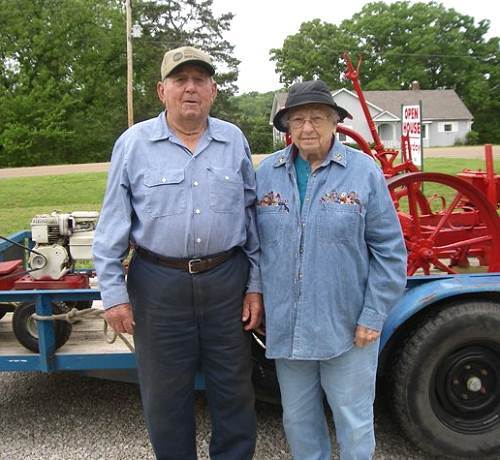
07 Elwood and Nadine Hachler
With the move to Eldon, the club became Branch 108 of the National Early Days Gas Engine and Tractor Association (EDGE & TA) with 51 members. We currently have about 70 members. The show has grown to include over 200 tractors on display along with gasoline and oil engines and other old and unique machinery. Today demonstrations include a sawmill, shingle mill, wheat threshing, straw baling, corn grinding, apple cider pressing, sorghum pressing and cooking molasses and blacksmithing. There is a tractor ride through Eldon on Friday morning, a pedal tractor pull on Friday afternoon, a garden tractor pull on Friday evening and a MATPA tractor pull on Saturday evening. Other activities for kids include a barrel train, face painting, clowns and a petting zoo. The show now has an attendance of 1500-2000 spectators.
The show is held the third weekend in September, Friday through Sunday.
Johnny’s daughter, Cathy DeGraffenreid, helped us acquire and set up our Lee Mace’s Ozark Opry display at the museum. Cathy has been a long time friend of the Mace family and worked at the Opry for many years before it closed. Assisting her in putting together the display was Jim Phinney, who also has been a long time associate of the Maces’ at the Opry (photo 08).
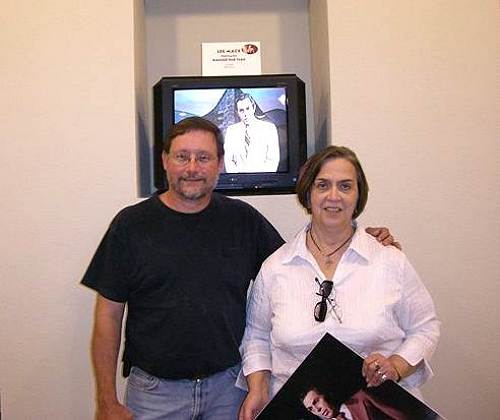
08 Jim Phinney and Cathy DeGraffenreid
The DeGraffenreid family is one of the earlier ones to settle in Miller County. Here is a short history of the family copied from the book Lake of the Ozarks 50th Year Anniversary:
DeGraffenreid Family
Fiftieth Anniversary Lake of the Ozarks 1982
p. 353
by Lloyd DeGraffenreid
The DeGraffenreid family arrived early in Miller County. John DeGraffenreid, who was born in Virginia in 1772 and his son, Tscharner C., born in Christian County, Kentucky in 1799, both entered land deeds in Miller County in 1836. By 1842 Tscharner C. owned land, part of which is in the southeast boundary of present day Brumley. Tscharner’s son, William Monroe DeGraffenreid, born in Christian County, Kentucky, 13 April, 1823, bought land the 13th of February, 1858, part of which is now Lee C. Fine Airport.
All of the sons of William Monroe DeGraffenreid and his wife, Elizabeth Ellen, owned farms near the Passover Community along the Glaize River in the 1880’s. These sons were Zachariah M., born 20 February 1846; Tscharner C. (Tess), born 30 January, 1853; and Phillip Piper, born 11 February, 1857. In addition to farming they did carpentry, blacksmithing, wagon making, gunsmithing and furniture making.
John’s place of burial is unknown. Tscharner C. and his wife, Cynthia, William Monroe and his wife, Elizabeth Ellen, were first buried at Graves Hill Cemetery near Passover. This cemetery was to be covered by water after construction of Bagnell Dam, so their graves were moved to Auglaize Cemetery where James Ballard and his wife Manervia Isabelle (Jeffries) are also buried.
The DeGraffenreids who came to Miller County are descended from the Baron Christopher DeGraffenreid, Landgrave of Carolina, who came from Bern, Switzerland and founded New Bern, North Carolina in 1710.
Here is the DeGraffenreid line from which Johnny DeGraffenreid originated:
John DeGraffenreid
Tscharner DeGraffenreid
William Monroe DeGraffenreid
Zachariah Marshall DeGraffenreid
George Riley DeGraffenreid
Children: Louie, Lloyd, Noma and Oma
Louie DeGraffenreid was the father of Johnny, Tennyson, Mary and Katherine.
Louie’s father, George Riley DeGraffeneid (photo 09), was the original owner and builder of the famous White House at Lake Ozark (photo 10).
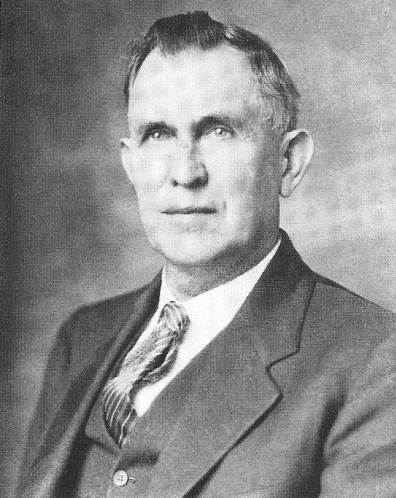
09 George Riley DeGraffenreid
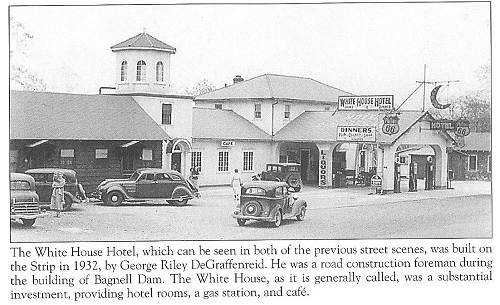
10 White House built by George DeGraffenreid - Weaver Collection
Click image for larger view
According to local historian Dwight Weaver, George was a road construction foreman during the building of Bagnell Dam. The White House, as it traditionally has been called, was a substantial investment, providing rooms, a gas station, and a café. It is the oldest building on the Bagnell Dam Boulevard. George was the original owner of the land. An oil company had bought the site from him planning to build a service station but later decided against proceeding returning the land back to George. He then took the original plans and built the building but operated it as a hotel and café. It opened for business on May 28, 1932 and became one of the most successful businesses at the Lake. The White House attracted many guests, especially those who loved to dance to the swing style orchestras which were popular there then. Many older people still alive today remember the fun times they had at the old White House. The building is still present on the “strip” at the Lake and now is especially known as the central location for the annual Oma Nova Day celebration at the Bagnell Dam area. Dwight Weaver presents a pictorial display there each year during the celebration. The building now is owned by George’s grandson, Tennyson DeGraffenreid (photo 11).
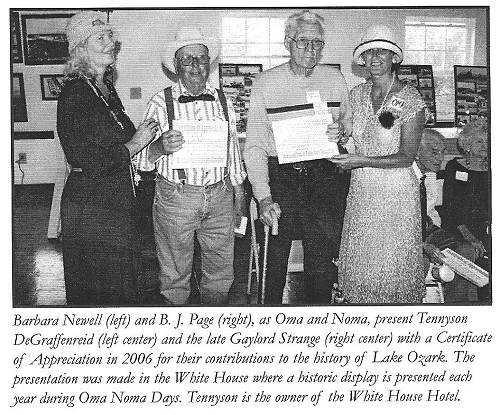
11 Tennyson DeGraffenreid at White House - Weaver Collection
Click image for larger view
Here is a photo of George Riley DeGraffenreid and his family (photo 12):
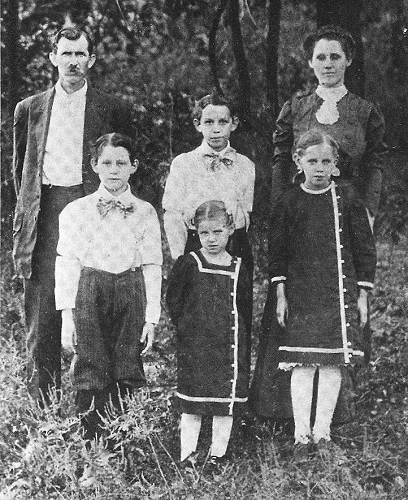
12 George Riley DeGraffenreid and Family
And here is the caption for the photo:
“Pictured are Mr. and Mrs. George Riley DeGraffenreid and their family about 1910. From left to right are Louie, Lloyd, Noma Ann and Oma.”
Tennyson and Johnny DeGraffenreid, who are brothers, are the children of Louie DeGraffenreid and grandchildren of George Riley DeGraffenreid.
Their aunts, Oma and Noma, children of George Riley DeGraffenreid, became famous in 1932 as they were the first to cross the Bagnell Dam after it opened (photo 13).

13 Oma and Noma DeGraffenreid
Here is how Noma described that day as recorded on our own website:
First to Cross the Dam
by Noma Ann DeGraffenreid
Mrs. Ralph O'Fallon, Miss Noma Ann DeGraffenreid and Miss Oma DeGraffenreid Kidwell, claim the distinction of being the first to drive across Bagnell Dam when it was opened to the traveling public. They left the George Riley DeGraffenreid home in a 1928 Chevrolet coach at 4:00 a.m. and arrived at the west end of the Dam at 5:00 a.m. Since the barriers were not taken down until 6:00 a.m., they sat in their car with the rain during down and waited patiently to be the first to cross. While crossing, they met four others cars and the Chevrolet sped away as the occupants strove to be the first to cross the Dam. When they arrived at the east end they looked back across the lake to see that the other cars had not yet crossed. They had succeeded in being the first to cross!
Now, some eighty years later after the crossing of the Dam by Oma and Noma their historic journey is celebrated every year at the Lake Ozark strip just west of Bagnell Dam.
Here is a photo of the parade of vintage cars crossing Bagnell Dam at a recent celebration of Oma Noma days (photo 14):
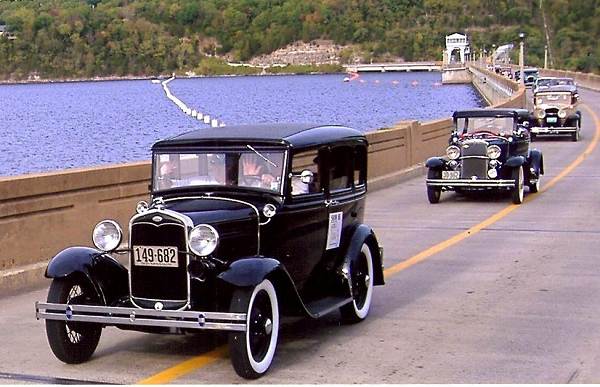
14 Oma and Noma Parade across Dam
Although this narrative concentrated on the family of George Riley DeGraffenreid, many other descendents of the original Miller County DeGraffenreids, John DeGraffenreid and his son Tscharner DeGraffenreid, have lived in the area especially in the Passover community (now flooded by the Lake). Their names can be found at several locations on some of the old plat maps.
That’s all for this week.
 Joe Pryor
Previous article links are in a dropdown menu at the top of all of the pages.
|

